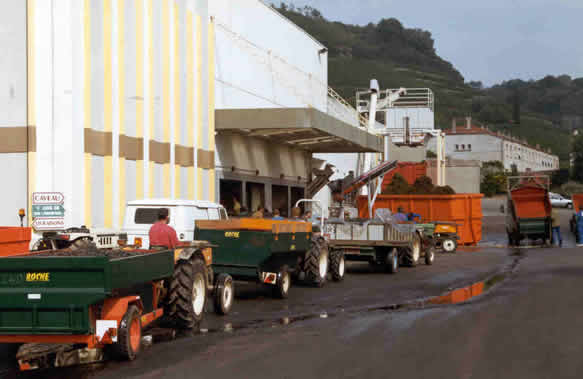
|
All
about...
As I write, September has begun, and for most of the wine
regions in the Northern hemisphere, this month will see the beginning
of the vintage. All eyes will be on the weather forecasts over the
next few weeks, as the climatic conditions from now till harvest will
largely determine the quality of the 2002 vintage. Check the current five day forecasts for weather stations near France's key regions The importance of vintages is one of the key factors that
reminds us that wine is primarily an agricultural product, made in the
vineyard. To the ‘branders’ this is a major inconvenience: they
would like wine to resemble other drinks, such as beer, vodka and
whisky, where the agricultural product is just a rather anonymous
starting point in the manufacturing process. For branded wines,
vintage variation is a major hassle, affecting continuity of supply
and product consistency. To the wine nut, vintages are instead a
source of variation that adds a delightful complexity to the process
of wine appreciation: after all, with each new vintage everything is
shaken up again, and we have yet more to learn. It can all be a bit bewildering to the novice. There are
already enough elements of wine appreciation that a budding wine nut
has to get their head around—regions, grape varieties and
producers—and now we have vintage variation as well. It’s tempting
to embrace the short cut of vintage charts, which rank vintages in
each region by marks out of 10, but this spawns the widespread
phenomenon of ‘vintageism’. This sort of abstraction just won’t
do for the serious student of wine. Why? Because each vintage, within
each region, some producers will have done better than others. There
are few universally brilliant vintages, just as there are few fully
dire ones. Besides, look at a particular producer’s performance over
a decade, and you may decide you actually prefer their efforts in some
of the less favoured years. Thinking rigidly in terms of good and bad
vintages is too simplistic: the reality is more complex than this. This said, there’s no doubting that some vintages, are on
average, more successful than others across whole regions. But this is
evidently a generalization. Because most people are lazy and prefer to
shop by the generalizations of vintages, people prepared to do their
homework and suss out the producers who performed well in ‘poor’
vintages will be able to drink well for far less. If you can free
yourself from the tyranny of vintage charts, then you may well find
some pleasant surprises in ‘off’ vintages. Be prepared for some
disappointments along the route, though. And in the absence of no
further information, vintage charts are probably a helpful guide,
particularly in the sorts of restaurants where the wine lists are
littered with off-vintages of famous names. What am I trying to say?
Well, you have permission to use them, but bear their limitations in
mind. So what makes a good vintage? One that produces an average
yield of healthy, ripe grapes, with good balance between sugar and
acid levels. As I’ve already alluded too, the weather at harvest
time and during the preceding couple of weeks is pretty critical for
this. The grapes need to finish the ripening process, both in terms of
sugar levels and physiological (or phenolic) ripeness; as harvest
approaches the potential alcohol will typically rise by a degree each
week. In addition, rain is a real problem at this stage, because this
will cause the grapes to bloat, risking dilution of the wine, and
encourage fungal diseases (you can’t spray just before picking).
This is why choosing when to pick is such an important decision for
producers: if rain is forecast, do you harvest a little early to be on
the safe side, or will you risk waiting? It’s easy to see how some
producers could do better than others in dodgy-looking vintages. The
other critical times are at the start of the growing season, when
there is a risk of frost in many regions, and during flowering—the
potential size of the crop is chiefly determined at this time. The
middle bit, roughly July and August, does matter, but not in the same
critical fashion. No doubt we’ll soon begin hearing reports from the key
regions about how the harvest is going. There’s always a sense of
anticipation at this time of year. After a couple of difficult years,
will it be Burgundy’s turn for a great vintage? Will Bordeaux match
the celebrated 2000 vintage? Will the Northern Rhône continue with
its lucky streak? And what of Alsace and the Loire, where vintage
variation is quite pronounced? Then there’s the multitude of regions
in Italy, Spain, Portugal, Germany and Austria… Vintages may add to
the complexity of wine, but they certainly add to the fun. 03/09/02 |
